Gary K. Nomeland is a a writer. His serial novel is called Goddess Moon. He co-wrote the lyrics to the coolest Death of Me song, PLEASE PLEASE PLEASE, and he will be a regular contributor to The SongBook Highway. Today he ruminates about the King of Pop…Mr. Bob Dylan. This was written before the death of Michael Jackson, which changes nothing.
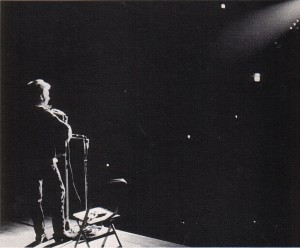
21st Century’s King of Pop?
As the 20th Century and the Second Millennium came to an end, it seemed as if the entire print world was obsessed with List Game; The Top 100 This, the 50 Greatest That, The Ultimate Thus. Our fave genius Einstein was The Person of the Century in some periodical. Religious rebel Martin Luther was shopped as The Person of the Millennium for another. Thankfully, Ronald Reagan has faded and, in a late breaking bulletin Jimmy Carter builds huts and collects Nobel Peace prizes. However, the greatest consensus in our frenzied listmania was Elvis Presley. The King of Rock’n’Roll, was universally anointed as the Most Influential Pop Culture Figure of the 20th Century, and I beg to differ. I believe the person who deserves that title is the skinny kid from Hibbing, Minnesota, Mr. Tambourine Man himself, Bob Dylan.
George Harrison, the late guitarist of a rather well known band, once commented in Rolling Stone that he believed that decades on, Bob Dylan would be the musician remembered and studied for his contributions to art and culture in our times and not the Beatles. He perceived Dylan as the most important pop music figure of our times, perhaps ever. So, I’ve got at least one guy dead guy on my side.
One thing to clear up. I ain’t takin’ one cotton-pickin’ thing away from Elvis. He was The Jolt. He set white kids free from the stodgy, boring 1950’s white pop music that just aped the dreamy/dreary song parade drivel that Mom and Dad loved. He personified sexual love, not hearts and flowers romance; he was the incarnation of the feelings of bodily pleasure and pain, not a young man who was too stuck in his White Protestant brain to know that his crotch was vibrating. Ed Sullivan knew exactly what he was doing keeping Elvis’ Jumpin Jolt off the TV screen.
But could Elvis ever mean more than his Jolt? When we break it down and look past his popularity and into his music the Jolt subsides. The great pop canon he represents is vast but not deep. Dave Marsh’s wonderful LIST of “The 1001 Greatest Singles Ever,” The Heart of Rock and Soul, notes Elvis’ hit making capacity. Elvis holds down 13 spots, but the “jolt factor” is demonstrated as seven of the songs come from 1954’s Sun Sessions and songs from 55 to 57, from the initial jolt area. The other songs are scattered like dried seeds across the early 60’s and only “Suspicious Minds” stands out as a refugee adult song that fills in our adult view of the MAN.
Despite his dominance of the hearts and charts, and when you look past the pop, Elvis’ music gives no real insight into our complicated modern world or the personal quest for meaning. He was an electrifying performer, but he wrote no songs of importance. He had no words to spill on a page, poetic words that could stand alone without any melody or musical instruments to push them along. Mick Jagger noted in a documentary that almost all rock’n’roll lyrics and sensibilities before Bob Dylan were basically mediocre, sophomoric odes about girls and cars. That comment includes a lot of Elvis’ hits.
On the other hand, Dylan does not rate many spots on Marsh’s list. But “Like A Rolling Stone” sits near the pinnacle of the list (#7) informing the music that must come after. Although Bob Dylan has not had a series of hit singles, he is the standard by which we judge any new songwriter, and his existence forced the term into our cultural existence.
Like A Rolling Stone vs. Suspicious Minds: On Like A Rolling Stone: The instant this record reached the Top 40, the rock and roll world exploded.(Dave Marsh, The Heart of Rock and Soul 1989 New American Library)
Like A Rolling Stone is the Promethean rock single set in the golden age of radio for which Tom Petty yearns. Once a upon a time you dressed so fine Dylan lashes out at class and complacency, No one in rock ever spoke like this or had the courage to ask his audience to come along and answer the question of our times, “How does it feeeeeeeel?”
On Suspicious Minds: Makes a formidable argument for Elvis-As-Artist, despite all the wasted years in Hollywood. (Dave Marsh, The Heart of Rock and Soul)
The Elvis who talks us here is more real and vulnerable. A tale of mutual distrust the singer longs for a way beyond the jaded past and on to a new stronger relationship. The song transcended the radio at that moment because s you could sense that Elvis wanted to move on, past the Colonel, past the awful movies, past his own bulky body to a place in song where he could find his real artistic expression and calling. But is clear, as the song whirls through its endless coda, that Elvis is indeed “caught in a trap” from which he will never be allowed exit. For all the great affirmation of this wonderful song one already senses Elvis’s impending doom and the failure in its promise.
FOLK AND BEYOND As a folk artist, Dylan brought into the 1960’s music explosion termed “folk rock” all of the mature insights and themes that had been celebrated in folk music for centuries. Sad, bitter love. The cruelty of the world. What it’s like to be on the bottom staring up over the lip of the gutter. Anti-war songs at a time when America was strongly militaristic. “Blowin’ in the Wind” was sung at more anti-Vietnam War rallies than any other tune by a mile. Dylan sang ballads against racism when he could’ve gotten his head blown off in many states by white-hooded fascists. And drugs. When “Mr. Tambourine Man” became a smash hit for the Byrds, the first great band of folk rock, hipsters couldn’t believe that such a dope song would be played on mainstream AM radio stations. “Take me for a trip upon your magic swirling ship/All my senses have been stripped/ And my toes to numb to step/And my hands can’t feel to grip…” That’s not booze, Mom. The point isn’t that dope is great, but that Dylan wrote a beautiful, seductive tune dealing with harsh realities, illegal behavior that was a massive part of the Counterculture’s quest to find liberation from the White Suburban Nightmare of Conformity. Almost overnight, any cool pop artist who wanted to stay hip started writing “heavy” lyrics, songs about things that mattered.
Dylan didn’t just stop there. He was very self-aware. In the film Don’t Look Back, he lip-syncs “Subterranean Homesick Blues” (a song about the deadly travails of dope dealing and revolutionary attitudes). The controversial poet Allen Ginsburg stands in the background. Here’s a folk-rocker advertising that he’s dragging the literary anarchy of the Beat Poets into pop music. How bohemian is that? Dylan was pouring spiritual intellectualism into the rock music Jell-O mold. His music was becoming aural heroin for the body and soul. Elvis couldn’t grasp something like that if it were an axe handle.
Even further, Dylan kept going. When he started to have doubts about Hippie Culture and the whole Brave New World psychedelic utopianism, he turned his back on Sgt. Pepper’s and Jefferson Airplane and that whole scene, and went back to roots music – John Wesley Harding and Nashville Skyline. In this era young people go back to the country, abandon the city, and ask questions about their lives in pastoral settings. And other musicians followed, In line, The Stones and Beatles and CSNY and The Band felt their way through Dylan’s natural path.
SHIFT Into the Seventies, with the rock critics were on his back about his significance Dylan shifted again. The Beatles were broken. The Stones were drugged out and jet set. Who was “The Voice” now for lonely baby boomers? Dylan released Blood on the Tracks, an album of anguish born out of his divorce. “Tangled up in Blue” was the track that said it all for the “Big Chill” generation. Still only in his thirties, Dylan’s song caught the alienation, sadness, self-doubt, searching and anxiety of the generation that once thought that it would really change the world:
“Some are mathematicians, some are carpenter’s wives I don’t know how it all got started I don’t know what they do with their lives… They’re an illusion to me now”.
This track held the wisdom and a feeling for what it means to begin growing old, to have plenty of past mistakes to ponder and regret.
He struggled again for the next decade or so, a pilgrimage that occasionally still could turn in dramatic fashion. Dylan became a born-again Christian, and the anti-religious venom of the music world was unleashed upon him. Later, he drifted from that conversion experience (and many a Doubting Thomas took a sigh of relief), but did they ever listen to the music? Slow Train Coming holds its own against any of his earlier album masterpieces. The later “Christian”tracks “Every Grain of Sand” and “The Bridegroom’s Still Waiting at the Altar” should be included in any list of Dylan’s best songs.
Into the Nineties, Dylan kept on making music and toured so much that he made other bands look like wimps. But he wasn’t quite on his game. Lukewarm reviews of his albums came easier and more often from even his most faithful fans among critics. He almost seemed out of his mind. He recorded an album of cover songs that included a track about a wiggling frog. Stop the madness!
NOT DARK YET But the old chameleon wasn’t dead yet. As more and more people were hoping he’d retire into the sunset, he pulls himself off the canvas and takes up the themes of death, age, disillusionment, love gone wrong (in fact, how the whole world’s gone wrong) when he records the bluesy Time Out of Mind. His youth gone, only the battered old man is left standing. Baby boomers are burying their friends and brothers and sisters now, not just parents. What does Dylan have to say about it? Bring it on. What’s the alternative?
Dylan follows with another masterwork, Love and Theft. He’s now an old minstrel in some dusty bar, scaring up memories of ghosts and old memories that seem to be out of focus yet make so much sense. Just put on “Sugarbaby”. There’s no place left for Las Vegas and sequined ridiculous costumes and karate moves when you truly comprehend that your understanding of life isn’t as honest as it ought to be.
Where would Elvis be now if he were among the living? Whatever he was up to, I don’t think it would be making challenging pop music about What’s Going On. Probably a little golf, the occasional TV appearance to sing a couple of oldies. Maybe sing a little Gospel. I wish Elvis would have lived to sing “It’s Not Dark Yet.” I wish Elvis was here to help us along.
But we do have Old Bob. He’s come through more ups and downs than anyone else could ever imagine. He’s still creating rich music with vital, contemporary themes. And he’s still going. What does the future hold for him? I don’t know, but at least I care.
I rest my case.
GK.
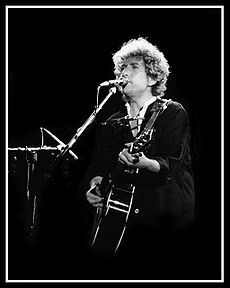
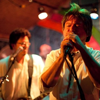
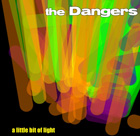
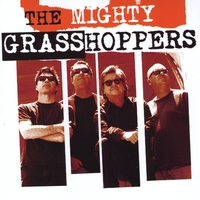
I, for one, love me some Oh Mercy. Shooting Star is one of most heartfelt tunes ever released. Ring Them Bells and Was it What You Want? make this one of his best and most unappreciated.
It’s so nice to read more of GK’s writing.
The Shot of Love album sparked my interest in Lenny Bruce when I was a teenager. “Lenny Bruce is dead, but his ghost lived on and on.”
The future holds. . . MORE TOURING! And now with the return of Charlie Sexton to the band, Bob seems totally energized! I saw his recent Rockford Il show, and it was better than I’d seen him since Charlie left at the end of 2002.
Morst,
Was Dylan playing the guitar?? or is he still doing the keyboard thing?